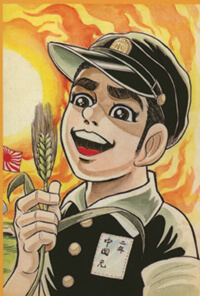Manga Mania

Kern’s class includes serious and hard-hitting manga, such as Barefoot Gen, which recounts life in Hiroshima after its bombing at the end of World War II. Keiji Nakazawa, courtesy of Last Gasp Publishing
Students get serious about Japanese comics.
In Adam Kern’s class, do not refer to mangas. The term manga takes no s, either in singular or plural. And if you describe a manga, do not call it a Japanese comic.
“A comic is a comedian,” Kern says. If you’re talking about a narrative form that uses graphics and language laid out in panels across pages — comic books, comic strips, and graphic novels — then “as a noun, the term is comics, whether singular or plural.”
Terminology is important to Kern, an associate professor of East Asian languages and literature who’s using his new course, East Asian 376: Manga, to examine this rising pop culture phenomenon.
Taught Tuesdays and Thursdays in Van Hise Hall, the course offers a survey of Japanese comic-book-style literature from the eighteenth century to the present, following the development of the form and examining its symbols and themes. His texts include such pop culture items as Astro Boy (originally a science fiction manga launched in the 1950s) and Sailor Moon (a super hero manga launched in the early 1990s and aimed at girls), as well as more mature works, such as Barefoot Gen (which describes life after the atomic bombing of Hiroshima, based on creator Keiji Nakazawa’s personal experiences) and Abandon the Old in Tokyo (a collection of adult-themed stories).
Kern, who spent several years in Japan and briefly worked in the publishing industry there while completing his doctorate, notes that manga is a far more prevalent art form in Japan than most people realize. Manga account for nearly a third of all printed materials sold there, appealing to all ages and classes of Japanese.
However, though manga may have deep roots in Japanese culture, Kern notes that it draws from eclectic sources and owes a heavy debt to American pop culture.
In a class session discussing Sailor Moon, for example, he traces that popular series back to a 1960s manga called Magical Witch Sally, which in turn was inspired by the American TV program Bewitched.
“A lot of what we think of as quintessentially Japanese is actually appropriated [from other cultures],” Kern says. “This kind of hybridity runs throughout manga.”
Afterward, the students closely examine Sailor Moon’s text, trying to learn its visual and verbal themes and symbols. Sailor Moon, Kern notes, is part of a particular tradition, called bishojo senshi manga, or “beautiful girl team manga.” Aimed primarily at a teenage, female readership, these books create a fantasy world to symbolize the transition of adolescence.
In Sailor Moon, the main character, Bunny, goes through a magical transformation to become the leader of a team of super heroes, the eponymous Sailor Moon. “It’s a sort of wish-fulfillment,” Kern says, “an answer to the question ‘What will I be when I grow up?’ ”
But, Kern notes, the book delivers its message of female empowerment with a dose of commercialism as well.
When one student notes that one of the magical transformations takes place in a video arcade, Kern confirms that this is no accident.
“It’s good product placement, isn’t it?” he asks. “Here’s this highly stylized crystallization of a dramatic moment, and the industry is using it for product placement.”
Over the semester, Kern leads his students through the many different forms of manga, showing them why this art form has been so popular in Japan for centuries. Manga, he says, offer deep insight into Japanese views on romantic relationships, family, and politics.
But Kern has a larger purpose for the course than just to teach students to be better at reading comics. He hopes that it will help raise interest and awareness of East Asian studies. “I’d like to make manga a gateway course,” he says. “I think it really ties in with our existing strengths in the department.”
Published in the Spring 2010 issue



Comments
Anime Discussion Online October 1, 2011
This sounds such an interesting course. Is this at a university based in the US? Here in the UK we don’t have anything like it. I wish we did and that Anime and Manga were more widely available in media and in situations such as this, rather than just online. Anyway, great post and very informative, thankyou.
http://www.livelyanime.blogspot.com